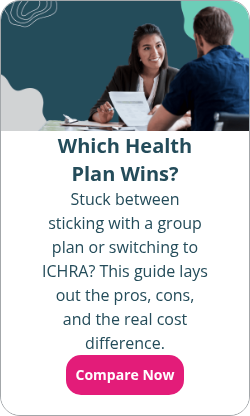Small group vs. large group health insurance
By Elizabeth Walker on June 12, 2024 at 10:00 AM
Traditional group health insurance is a type of health insurance plan employers offer their employees and their families at a discounted premium rate. Because of its familiarity and tax benefits, group health insurance is a sought-after employee benefit. It can help employers attract and retain talented workers.
There are two sizes of group health insurance: small and large. Both small and large group health insurance plans have pros and cons. While they do have similarities, there are some key differences. Whether an employer can secure small or large group health insurance mainly depends on their company size.
This article explores small and large group health insurance, how they compare, and why employers should consider a health reimbursement arrangement (HRA) as a flexible and budget-friendly alternative.
Takeaways from this blog post:
- In most states, small group health plans are for employers with between two and 50 employees. Large group health plans are for organizations with 51 or more employees.
- Small and large group health plan premiums vary. However, small group plans can be more expensive for employers and don’t allow for insurance rate negotiations, like large group plans.
- Group health plans have annual premium rate hikes and aren’t as flexible for employees as health reimbursement arrangements (HRAs), which allow for tax-free reimbursements for medical expenses.
What is small group health insurance?
Small group health insurance is a health plan that small employers offer their employees. Most states define a small group as an organization with between two and 50 employees. However, some states consider a company with between two and 100 employees a small group.
The Affordable Care Act (ACA) only requires employers with 50 or more full-time equivalent employees (FTEs) to offer health insurance. However, many employers with fewer than 50 FTEs still choose to do so, as providing comprehensive coverage is a great way to make your company and benefits package more attractive to employees.
To qualify for a small group health insurance plan, you must:
- Have between two and 50 full-time employees
- If you’re in California, Colorado, New York, or Vermont, a small group is any employer with between two and 100 employees.
- Pay a portion of your employees' health insurance premiums
- Ensure you meet your state’s and health insurance company’s minimum participation requirements
- Most insurance companies require a participation rate between 50% and 75%. However, if you enroll in a group plan through the Small Business Health Options Program (SHOP) between November 15 and December 15, you don’t have to meet a participation rate threshold1.
There are various types of small group health plans available. However, all small group plans must meet ACA requirements. This means insurers must classify them using the metallic tiers of coverage—bronze, silver, gold, and platinum—and cover the essential health benefits. These include emergency services, prescription drug coverage, hospitalization, and more.
Small group plans must also meet a specific medical loss ratio, which means they must spend at least 80% of their premium income on medical-related expenses and no more than 20% on administration costs.
You can purchase a small group plan through an insurance company, agent, or broker anytime during the year. If you buy your plan on the SHOP marketplace, you may qualify for the Small Business Health Care Tax Credit to save on premium costs.
What is large group health insurance?
As the name suggests, large group health insurance is for larger organizations. Most states consider a large group an employer with 51 or more employees. However, some states define it as an organization with 101 employees or more.
The ACA’s employer mandate requires all applicable large employers (ALEs)—or those with at least 50 FTEs—to offer their employees affordable health insurance with minimum essential coverage (MEC) and minimum value or face tax penalties. Most ALEs choose a group health insurance policy to satisfy the employer mandate.
To qualify for large group health insurance options, you must:
- Have 50 or more full-time employees
- If you’re in California, Colorado, New York, or Vermont, a large group must have at least 101 employees.
- Pay a portion of your employees' health insurance premiums
- Ensure you meet your state’s and health insurance company’s minimum participation requirements, which is typically 70%
- Fulfill the group coverage reporting requirements, such as reporting the cost of health insurance on your employees’ Form W-22
The biggest difference between small and large group health insurance is group size. But there are other differences. For example, small group plans must offer medical coverage for the essential benefits. However, large group plans are exempt from this requirement.
Additionally, the ACA requires large group markets to spend at least 85% of premiums on medical-related expenses, leaving no more than 15% for administrative costs.
Large group plans don't have to use the metallic tiers classification either. This gives insurance providers greater flexibility with their plans. Insurers can also offer add-on coverage options to large group plans, such as ancillary benefits, for an extra cost.
Like small group health insurance, employers can purchase a large group plan anytime during the year. However, eligible employees typically can only enroll during the plan’s annual open enrollment period unless they qualify for a special enrollment period.
How much does small group and large group health insurance cost?
Small and large group health plan premiums vary based on several factors. For example, small group plans must follow specific ACA guidelines. This means insurers can only use age, family size, location, tobacco use, and plan type to determine the premium rate. Depending on your type of workforce, this can make small group plans very expensive. Small employers can't negotiate or receive discounts once the insurer sets the rate.
Insurers can use more factors to determine large group insurance premiums, like the number of participating employees, sum insured, industry, the company’s claims history, and add-ons. Insurers underwrite large groups as one group, meaning they consider all employees an equal risk and charge an equal amount. But, employers or brokers can negotiate the rate with the insurer. And, if they choose add-ons, they may be able to receive a bundling discount.
But to give you an idea of the average costs, let’s look at some numbers. According to KFF, the average annual premium for group health insurance in 2023 was $8,435 for self-only health coverage and $23,968 for family coverage3. These figures represent averages for small and large group policies combined. Of these amounts, employers contributed an average of $7,034 annually toward self-only plans and $17,393 toward family plans.
To break it down further, the average annual premium for self-only coverage was $8,722 for small businesses and $8,321 for large companies. Family coverage was $23,621 for small employers and $24,104 for large employers. KFF considers small businesses to have between three and 199 workers and large companies to have 200 or more workers.
How do small and large group health insurance compare?
The chart below summarizes how small group health insurance compares to large group health insurance.
|
Small group health insurance |
Large group health insurance |
|
|
How many employees must the employer have? |
Between two and 50 full-time employees. In California, Colorado, New York, and Vermont, you must have between two and 100 employees. |
Fifty or more full-time employees. In California, Colorado, New York, or Vermont, you must have at least 101 employees. |
|
Do employers have to pay a portion of their employees’ monthly premiums? |
Yes. |
Yes. |
|
What are the participation rate requirements? |
While it varies by state and insurer, the participation rate is typically between 50%-75%. If you enroll in a plan through the SHOP program during open enrollment between November 15 and December 15, you don’t have to meet the participation rate. |
While it varies by state and insurer, the participation rate is typically between 50%-75%. |
|
Does the plan have to cover essential health benefits? |
Yes. |
No. |
|
Do insurers have to follow the metallic tiers of coverage classification? |
Yes. |
No. |
|
What is the medical loss ratio? |
Small group markets must spend 80% of their premium income on medical expenses and 20% on administration costs. |
Large group markets must spend 85% of their premium income on medical expenses and 15% on administration costs. |
|
When can employers purchase the plan? |
Any time during the year. |
Any time during the year. |
|
How can insurers determine the premium rate? |
Under ACA guidelines, insurers can only use age, family size, location, tobacco use, and plan type to determine the premium rate. |
Insurers can use age, number of participating employees, location, plan type, family size, your company’s medical claim history, sum insured, industry, and add-ons to determine the premium rate. |
|
Can employers or brokers negotiate the premium rate? |
No. |
Yes. |
How you can leverage an HRA as an alternative to group health insurance
Group health insurance is often the first thing that comes to mind when to small or large employers consider a health benefit. However, it comes with annual rate hikes and a lack of flexibility for employees, which can make it unappealing in the long run. That’s why many organizations have switched to more personalized and flexible alternatives, like an HRA.
An HRA is an IRS-approved employer-funded health benefit that allows employers of all sizes to reimburse their employees tax-free for more than 200 qualified medical costs. Depending on the type of HRA you offer, you can also reimburse your employees for their individual plan premiums.
Instead of working with an insurance company, you set a monthly HRA allowance. This is the most you’ll spend each month per employee. Your employees buy eligible medical services and items out-of-pocket. Then, your employees submit proof of their purchases for review to ensure the expenses comply with IRS regulations. Once you approve the expense, you reimburse your employees up to their allowance amount.
An HRA helps you control your benefits budget. Unlike group health plans, you won’t experience any annual rate hikes unless you increase your HRA’s allowances. This is especially impactful for small employers.
“Due to the smaller risk pool [of small group plans], one high claim can significantly impact overall costs. However, small businesses can leverage HRAs to offset high deductibles, achieving a balance between cost control and employee satisfaction,” says John Crist, founder of Prestizia Insurance.
HRAs also have tax benefits. All reimbursements are tax-free for employers and income-tax-free for employees if they meet the participation requirements.
You can administer three types of HRAs with PeopleKeep:
- Qualified small employer HRA (QSEHRA): A QSEHRA is for small employers with fewer than 50 full-time equivalent employees (FTEs) that don’t offer a group plan of any kind. The IRS sets annual maximum contribution limits for QSEHRAs, but there are no minimum limits. Full-time W-2 employees are automatically eligible for the benefit but must have a health plan with MEC to participate. This can include group coverage from a spouse or parent.
- Individual coverage HRA (ICHRA): An ICHRA is available to employers of all sizes and has no minimum or maximum contribution limits. For extra flexibility, you can vary allowance amounts based on employee classes. Employees can opt in or out of the benefit but must have a qualifying form of individual coverage to participate.
- Group coverage HRA (GCHRA): A GCHRA is for employers of any size who offer a group health plan. Only employees enrolled in their employer’s group plan can participate. Employees can receive reimbursements for out-of-pocket healthcare costs their group plan doesn’t fully cover. But, group plan premiums are ineligible expenses. They have no contribution limits and have employee class customization options.
No matter your company size or budget, there’s a customizable HRA for you and your employees.
Conclusion
Group health insurance coverage continues to be a popular employee benefit across the U.S. However, its cost, participation requirements, and rigid structure may not make it the right choice for every employer’s needs. Luckily, more modern health coverage options are available for small and large companies.
Personalized health benefits, like an HRA, offer more savings and customization for employers of all sizes. Better yet, they provide employees and their families greater flexibility and control over their medical decisions.
This blog post was originally published on August 23, 2013. It was last updated on June 12, 2024.
1. https://www.healthcare.gov/small-businesses/choose-and-enroll/qualify-for-shop-marketplace/
Check out more resources
See these related articles

What is group health insurance?
Curious about group health insurance? This comprehensive guide explains the ins and outs of group coverage and how it works for your organization.

Small group health insurance for beginners
Explore the basics of small group health insurance. Learn how it works, who qualifies, and how to choose the best plan for your small business.

Offering a QSEHRA vs. group health insurance
Compare QSEHRA with group health insurance. Learn the differences in cost, flexibility, and benefits to help you choose the best option for your business.



